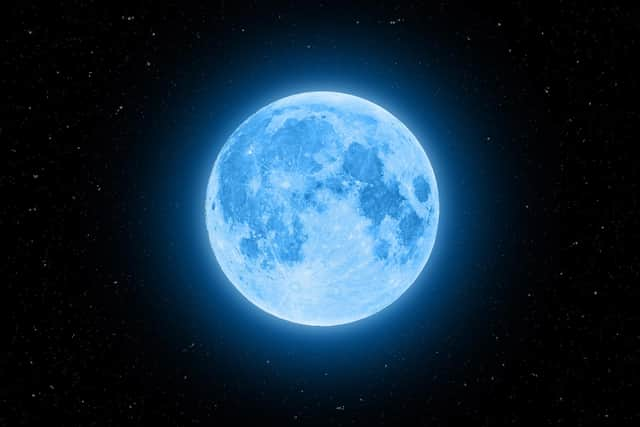When is the next full moon? Date of August 2021 full moon in UK, what is a Sturgeon Moon - and how to see it
and live on Freeview channel 276
Moongazers will soon be able to spot a rare “Blue Moon”.
August’s full moon should be visible this weekend, but it won’t actually appear blue in the sky.
It gets its name as it will be the third full moon out of four this summer, when usually there’s only three full moons a season.


This next full moon is also known as the “Sturgeon Moon”.
Advertisement
Hide AdAdvertisement
Hide AdSo, when will it appear, why does the moon have that name and how can you see it?
Here’s what you need to know.
Why do full moons occur?
A full moon is when the moon appears as a complete circle in the sky, thanks to the sun’s rays lighting up the whole side of the moon that is facing the Earth.
This makes the full side of the moon visible to the naked eye, since it produces no light of its own.
The main source of light for the moon is the sun, although a small amount comes from distant stars and the reflection of light from the Earth.
Advertisement
Hide AdAdvertisement
Hide AdThe time it takes from a new moon - when the moon is between the Earth and the sun’s orbit and the side facing us is in darkness - to become a full moon is about 29.5 days.
When is the August full moon?
The next full moon will be visible on Sunday 22 August 2021.
The one before that was the Buck Moon, which happened on Saturday 24 July.
What is a Sturgeon Moon?
Advertisement
Hide AdAdvertisement
Hide AdEach full moon of the year has a name which comes from ancient origins.
Over time, different cultures have given names to full moons across the lunar calendar, with many coming from Native American tribes who used the cycles of the lunar phases as a method of timekeeping.
A lot of the names are associated with seasonal signs, like the blooming of flowers.
These names were then adopted by colonial Americans and subsequently entered popular culture.
Advertisement
Hide AdAdvertisement
Hide AdIn this case, the Sturgeon Moon refers to the sturgeon fish which North American tribes would see at this time of year.
It doesn’t have anything to do with Nicola Sturgeon, Scotland’s First Minister, who shares the same last name as this full moon.
The Sturgeon Moon is also referred to as a Blue Moon due to the rarity of its appearance.
It will be the third full moon out of four during the Northern Hemisphere’s summer season.
Advertisement
Hide AdAdvertisement
Hide AdThat’s where the phrase “Once in a blue moon” comes from, when people are describing an event that doesn’t happen often.
Meanwhile, July’s Buck Moon was given its name after male deer regrowing their antlers in the summer.
How can I see the August full moon?
Keen moongazers will be able to spot the Sturgeon Moon before sunset on 22 August - this weekend - and it will appear brighter as the sky gets darker.
Advertisement
Hide AdAdvertisement
Hide AdIt will be at its fullest at 1.01pm in the UK, although the moon might be difficult to spot at this time if it’s a sunny or cloudy day.
When is the next full moon?
There are 12 full moons in 2021, each with its own unique name.
After August’s Sturgeon Moon, the next full moon to appear will be the Harvest Moon in September.
The full list of full moons for this year is:
| 28 January | Wolf Moon |
| 27 February | Snow Moon |
| 28 March | Worm Moon |
| 27 April | Pink Moon |
| 26 May | Flower Moon |
| 24 June | Strawberry Moon |
| 24 July | Buck Moon |
| 22 August | Sturgeon Moon |
| 21 September | Corn Moon/Harvest Moon |
| 20 October | Hunter's Moon |
| 19 November | Beaver Moon |
| 19 December | Cold Moon |
Two of these are supermoons - the Pink Moon in April and the Flower Moon in May - when the full moon appears bigger and brighter than usual.
Comment Guidelines
National World encourages reader discussion on our stories. User feedback, insights and back-and-forth exchanges add a rich layer of context to reporting. Please review our Community Guidelines before commenting.
